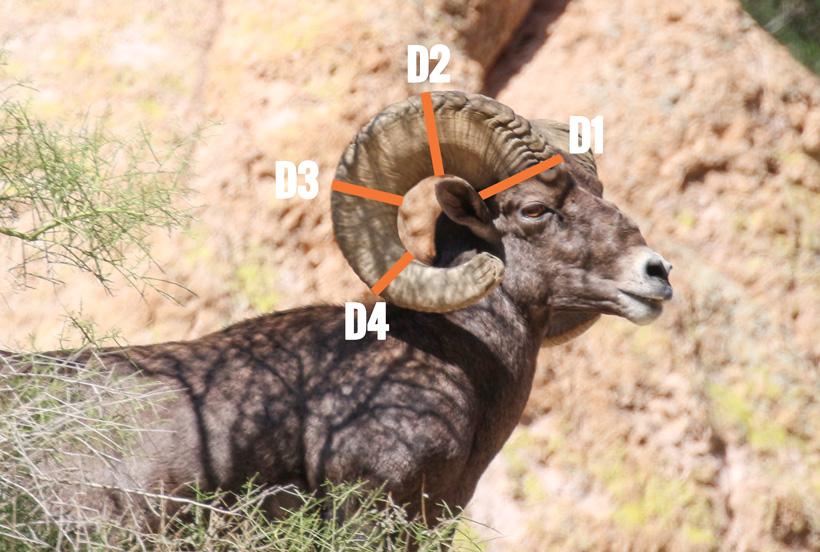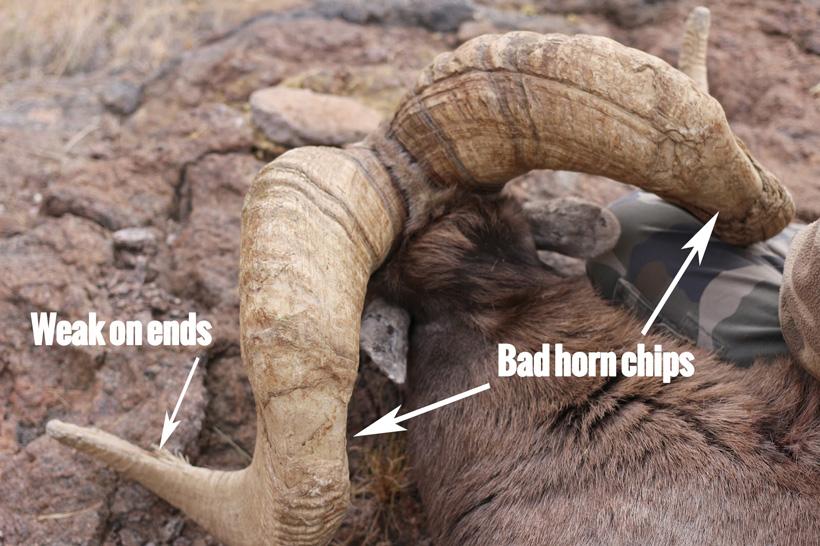







Claude Warren's giant Arizona Nelsoni desert bighorn showing the large chip in the right horn which caused the 2nd quarter measurement to lose 3.5 inches.







You can see the wide flare of the horns which usually equates to longer horns. 39" and 38" in this case.



Great example of a really large depth of curl. You could fit a volleyball inside of the circle, which equates to a longer horn.
In previous articles, we have covered aging and scoring bighorn sheep. In this article, we will discuss how to field judge bighorn rams.
When field judging bighorn sheep, the first view to look for is the head-on view; then, look at the side profile of each horn. In the head-on view, look for the horn configuration to be like a square box with the bottom of the horns below the jaw. Horns should go up off the top of the head, not straight back. As the horn curls up, this is where the side view becomes important. Horns should go up and then back away from the skull as much as possible before they drop downwards to create the most length. You want the horns to drop down as far as possible. That drop creates a deep curl. Look for horns that tip up toward and past the nose as much as possible. The mass should look “puffy” and fat throughout the whole horn all the way to the tips.
Each bighorn has a different body size and characteristics, which is an important part of determining the size of their horns while in the field. It is very important to make sure that the ram you are evaluating is with other sheep so you can analyze the body size compared to his wild counterparts. Some rams may look impressive standing alone yet blend in when with a group of rams. It’s important to be able to spot the difference.
A Boone and Crockett (B&C) record book desert sheep which has to score 168” or above will generally have 100” of mass; all you have to do is estimate the horn lengths and you have the estimated score. For instance, if I thought a ram’s horns were 36” long plus 100” of mass, then I would score this ram at 172” (36+36 = 72+100 = 172”). A B&C record book Rocky Mountain bighorn ram which has to score 180” or above will usually have at least 105 inches of mass.
The first step to field judging rams is to get familiar with other rams that have been harvested in your unit or area. Gather all of the data that is available from sources like Insider and local game and fish departments. This will provide an accurate assessment of the base sizes from previous rams that have been harvested, which you need for comparison when you see a big mature ram in the field. Try not to assume that the ram you are looking at has bigger than the average bases. If you use the average base size as a baseline and then estimate the remaining measurements from there, you will be more accurate. Store the data gathered on your phone so you have it in the field. Try to analyze every bighorn sheep photo that you can get your hands on. When you are in the field, you can evaluate the ram you are looking at compared to the data and photos on your phone. Use technology to your advantage. When field judging rams, the first and most important view I am looking for is front on. I am looking for that ram to “pop.” Some people call it the “it” or “wow” factor. Most of the time mature rams always look big, but if you don’t get that immediate “wow” when looking at it, then it is probably not that big of a ram. The best case scenario is spotting a band of rams together with only one that stands out in mass and length.
Mass accounts for approximately 60% of the total score on a mature desert and Rocky Mountain bighorn ram. Most of the desert rams that hit the high 160s will have approximately 100” of mass. Most rams that have 100” of mass have roughly a 15” base. When you get into the 15 ½” to 16” bases, you can get up to 105” or 106” in mass depending on the second and third quarter measurements. Mass beyond that is very rare. Some of the biggest desert bighorn rams that I know of have 110” of mass and scored around 185”. By adding a rough mass estimate with the two horn lengths, determines a representative score much simpler and faster than trying to guess every measurement.
When I am evaluating a ram, I try to split the horn into each quarter measurement. I look for big chips or dents in the horn that may greatly affect the score of that ram. Let’s say the longest horn is 36”. Divide that by four, which equals 9”. Try to look at every 9” of horn to see if there are any chips or holes where the quarter measurement will be taken. Watch out for holes or cracks in the horn where your mass measurements are going to fall. Some rams have big chunks in their horn that can greatly affect the score, yet some chunks fall outside those exact spots where the measurement is taken. In order for a ram to be a real high scorer, the mass needs to carry out all the way throughout the horn past the third quarter measurement. One thing to note is the importance of keeping track of a ram’s mass per side.
A good rule of thumb is to judge the bases and then use this formula: minus one, two and six.
For example, if a ram has a 15” base: minus one for the first quarter measurement so it becomes 14"; then minus two for the second quarter measurement so it becomes 13"; then minus six for the third quarter measurement so it becomes nine. That would give the ram 15", 14", 13", 9" totaling 51” of mass. I have found this to be fairly accurate.
In general terms, good solid desert bighorn ram (164 to 168”) will have 33” or 34” horns, a big ram (166 to 170”) will have 35” or 36” horns and really big rams (170”+) will hit 37” or 38”. Anything bigger than that will look ridiculous. Mature rams will rarely have horns under 30” unless he's broken or severely broomed. Look at the horn drop, at how far the horns come off the head (side-to-side), how far up and back they come out of the bases, whether the tips turn up, and the amount of brooming. Looking at a bunch of rams helps when it comes to determining horn length. When you look at a ram from the side, the larger the hole the longer the horn. Look at the circle and determine if can you fit a baseball, softball, or soccer ball in the inner hole. From the side, if the lower edge of the horn comes down to the bottom of the jaw and the horn tips come up even with the bridge of the nose, the horns are longer than normal. The one thing that I look for that makes a ram exceptional is horn drop. I have found if the whole horn drops below the jaw line, you have an exceptional ram nearly every time. But be careful when using this indicator since you can also be fooled by drop if the horn lays really flat on the ram’s head. Ideally, you want a horn to come high off of the head and then back and drop real low below the jaw.
6 years oldLeft horn longer than right
Left horn: 35 4/8”, 14” bases, 13.5”, 11.5”, 8” = 82.5”Right horn: 34 4/8”, 14” bases, 13.5”, 11.5”, 8” = 81.5”Score: 164”
6 years oldRight horn longer than left
Left horn: 35”, 15”, 14.5”, 12”, 8.5” = 85”Right horn: 36”, 15”, 14.5”, 12”, 8.5” = 86”Score: 171”
8 years old
Left horn: 39 ⅛”, 15”,14 2/8”, 12”, 8 4/8” = 88 ⅞”Right horn: 38 4/8”, 15”, 14 ⅛”, 10 ⅝”, 8 4/8” = 86 ⅝”Gross score: 175 4/8”Net: 174”
6 to 7 years old
Left horn: 37 0/8”, 16 ⅜”, 15 ⅝”, 13 6/8”, 9 ⅜” = 92 ⅛”Right horn: 37 2/8”, 16 4/8”, 15 ⅝”, 13 6/8”, 9 2/8” = 92 4/8”Gross score: 184 ⅝”Net: 184 ⅜”
Listen on iTunes
PB Player
Be careful of rams that are standing alone and not with other sheep. They can be deceiving. Sometimes they look big alone, but once they are part of a group of sheep, they become average.
If you over judge the bases and then base all of your measurement estimations on this over-judgment, the ram can shrink real fast. Try to be as accurate as possible on your base estimation.
The first quarter measurement will usually be within a half inch of his base measurement.
Be very careful of tight curled rams. They tend to be short on horn length. Tight curled rams usually look heavier than they actually are.
Big rams almost always look giant from every angle. If you have a weak angle, then it is probably not a giant.
Look for rams with a large curl depth. Usually those rams score much higher than tightly curled rams.
Nelsoni desert rams can be difficult to judge because they usually have lots of flare and, from the side, it is hard to estimate length. Keep in mind that usually more flare means a longer horn, which is good for score.
Width is measured for submitting a B&C entry, but does not actually count in the score calculation.
Because judging body size is so important, remember that the big rams’ butts will discolor and have a dingy look. The white patch on the butt will get really off colored. They will usually have a big pot belly and they will also have a swayed back.
Horn comes high off of his head and has good tip up.
Ram looks tight curled.
Inner circle or donut seems tight and small.
Large chip on left horn.
The bottom of the horn not quite to the bottom of the jaw.
Age (not an old ram).
Good drop.
Good depth of curl.
The horns tip up real well.
Horn lays flat off of his head.
Age (not an old ram).
Incredible length.
Horns tip up.
Width definitely lengthens the horn.
Bad chip in second quarter on left and right side.
A little wispy on the ends.
Good drop.
Incredible depth of curl.
A little wispy out at the third quarters.